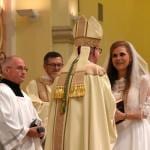
An excellent rejoinder from Timothy O’Malley in Church Life Journal:
In a recent blog post, Fr. Michael White (author of Rebuilt: Awakening the Faithful, Reaching the Lost, and Making Church Matter) argues that young children and toddlers are unable to understand the Eucharistic liturgy, and therefore a parish ought to offer a “special” worship experience for them that is age appropriate. Lacking the capacity to participate in the act of Eucharistic worship, they create a disruption that disturbs the ability of the parent to “devote their full attention to worship…”
…From my perspective, Fr. White’s argument is flawed not simply because he argues for the exclusion of young children from the act of parochial worship. Rather, the blog post reveals a misunderstanding of the nature of the liturgical act itself. This misunderstanding is not unique to Fr. White, but has infected most Catholic parishes in the West well before Vatican II. When one reduces the liturgical act to “understanding,” then there is an erasure of the contemplative, aesthetic, and thus embodied formation that is integral to a worshipful existence.
He adds:
Fr. White is wrong both theologically and psychologically. The young child is looking at the altar because the young child is always looking, perceiving, and imitating. No, the young child is not able to comprehend the sermon that is given or the particular meaning of the opening collect or why there is a pelican or Lamb on the altar. But the young child is discovering in the act of Eucharistic worship according to his or her capacity that this act really matters. The child perceives the facial features of adults, who are ideally engaged in contemplative wonder at the Eucharistic mystery. They hear the reverberant notes of the organ and they see and smell incense. They are learning the very meaning of what it means to be a liturgical creature even as they sleep in their mother’s or father’s arms during the Eucharistic liturgy.
Young children perceive the mystery of divine love in the mode that is appropriate to an infant or young child. To deny them this act of perception is in essence to say that God can only communicate in the mode that we find appropriate for our sophisticated, intelligent, rational, and adult faith. It is to eliminate the human body itself from the act of worship, since the primary activity is the communication of a message.
In this sense, Fr. White’s blog post is but endemic of Catholic worship in the United States at this stage. Liturgies are cacophonies of verbal proclamations, of sermons, of explaining rites and the meaning of feasts. There is so little to behold in churches that have been built as suburban shopping malls. Music is chosen not because it provides something to perceive, the beauty of ordered sound used to worship God, but instead to get across a “message” in hymn texts that are often more ideological than aesthetic or theological. There is often so little gravitas to the activity of worship, a sense that we have to adjust ourselves to adore God, since what we long for is a pleasing and meaningful act of worship.
Perhaps, what we need to do is not exclude children from the act of worship. Instead, we must understand liturgical worship as if the primary participants in the act of worship will be infants. Instead of relying on endless speech, on communication media including video screens, we must create spaces where all the senses are involved in worship. Emphasizing understanding through speech brackets out a good deal of what it means to be a human being.
There’s much more. Read it all.
















